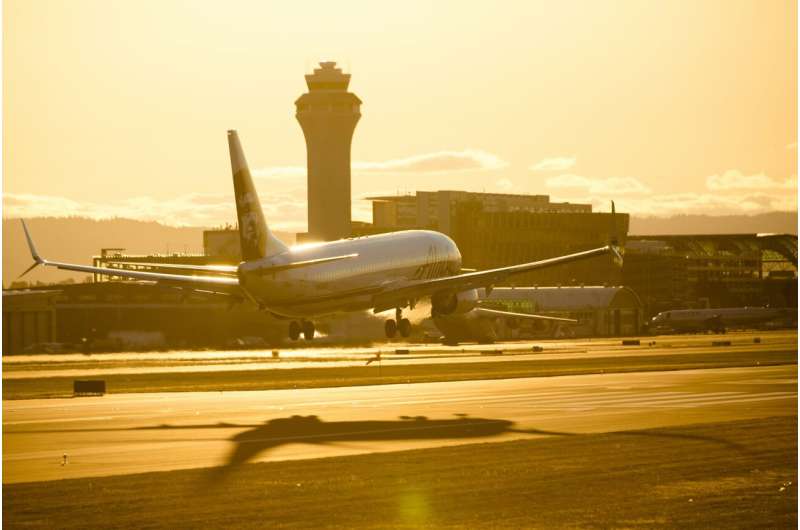New computer models can help improve airport landing delays
Airport operations are affected by the unpredictable nature of flight times, departure delays, weather conditions, and other factors.
Research from Lancaster University Management School (LUMS) uses computer simulations to show how airports can arrange landings to help reduce delays and improve punctuality.
In their new paper, Dr. Rob Shone, Distinguished Professor Kevin Glazebrook and Distinguished Professor Konstantinos Zografos employ novel and complex models to estimate aircraft arrival times, using simulations that account for changes in-flight to capture real-life situations in a more accurate manner.
The article, “A New Simheuristic Approach for Stochastic Runway Scheduling,” is published in the journal Transportation Science.
Lead author Dr. Shone said, “Our paper looks at the best way of controlling the sequence of landings at a busy airport. By doing so, we can influence key performance indicators around punctuality and delays—major issues that affect passengers every day.
“Airport operations are affected by uncertainty due to the unpredictable nature of flight times, departure delays, weather conditions, etc. Existing methods for optimizing aircraft landing sequences do not necessarily consider all of these different sources of uncertainty. By using computer simulations, we can test the possible consequences of different sequencing decisions under highly uncertain conditions.
“Our research uses a unique combination of simulation and optimization (known as simheuristics) to find the best way of sequencing aircraft landings. Simheuristics is an emerging field of research that offers exciting possibilities for improving decision-making in complex environments such as air traffic control.
“Our work shows it could lead to reductions in airborne holding delays of more than 20% compared to the simple ‘first-come-first-served’ rule where planes land in order of their arrival at their destination and improve punctuality across airport operations.”
More information:
Rob Shone et al, A New Simheuristic Approach for Stochastic Runway Scheduling, Transportation Science (2024). DOI: 10.1287/trsc.2022.0400
Citation:
New computer models can help improve airport landing delays (2024, February 27)
retrieved 27 February 2024
from https://techxplore.com/news/2024-02-airport-delays.html
This document is subject to copyright. Apart from any fair dealing for the purpose of private study or research, no
part may be reproduced without the written permission. The content is provided for information purposes only.

Airport operations are affected by the unpredictable nature of flight times, departure delays, weather conditions, and other factors.
Research from Lancaster University Management School (LUMS) uses computer simulations to show how airports can arrange landings to help reduce delays and improve punctuality.
In their new paper, Dr. Rob Shone, Distinguished Professor Kevin Glazebrook and Distinguished Professor Konstantinos Zografos employ novel and complex models to estimate aircraft arrival times, using simulations that account for changes in-flight to capture real-life situations in a more accurate manner.
The article, “A New Simheuristic Approach for Stochastic Runway Scheduling,” is published in the journal Transportation Science.
Lead author Dr. Shone said, “Our paper looks at the best way of controlling the sequence of landings at a busy airport. By doing so, we can influence key performance indicators around punctuality and delays—major issues that affect passengers every day.
“Airport operations are affected by uncertainty due to the unpredictable nature of flight times, departure delays, weather conditions, etc. Existing methods for optimizing aircraft landing sequences do not necessarily consider all of these different sources of uncertainty. By using computer simulations, we can test the possible consequences of different sequencing decisions under highly uncertain conditions.
“Our research uses a unique combination of simulation and optimization (known as simheuristics) to find the best way of sequencing aircraft landings. Simheuristics is an emerging field of research that offers exciting possibilities for improving decision-making in complex environments such as air traffic control.
“Our work shows it could lead to reductions in airborne holding delays of more than 20% compared to the simple ‘first-come-first-served’ rule where planes land in order of their arrival at their destination and improve punctuality across airport operations.”
More information:
Rob Shone et al, A New Simheuristic Approach for Stochastic Runway Scheduling, Transportation Science (2024). DOI: 10.1287/trsc.2022.0400
Citation:
New computer models can help improve airport landing delays (2024, February 27)
retrieved 27 February 2024
from https://techxplore.com/news/2024-02-airport-delays.html
This document is subject to copyright. Apart from any fair dealing for the purpose of private study or research, no
part may be reproduced without the written permission. The content is provided for information purposes only.
